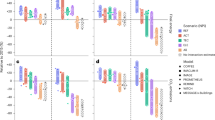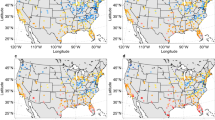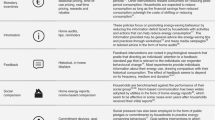Abstract
The European Union (EU) has established an ambitious policy framework for demand-side mitigation in buildings towards net-zero targets. Here, we conduct a comprehensive quantitative assessment of 384 demand-side policy combinations for residential space heating that complement supply-side decarbonization efforts. We show that implementing the EU Emissions Trading System 2, even when combined with energy supply decarbonization, falls short of climate targets. Beyond the EU Emissions Trading System 2, we emphasize the need for ambitious heat-pump subsidies as a critical component of a successful strategy. Conversely, a large-scale generic ‘Renovation Wave’ contributes modestly to decarbonization, is not a cost-effective strategy at the EU level and requires significant public spending increases. We advocate for the implementation of a carbon tax, paired with substantial heat-pump subsidies and targeted incentives for home insulation by country and building. This approach supports the decarbonization of the residential sector, limits the strain on the electricity grid and alleviates energy poverty.
This is a preview of subscription content, access via your institution
Access options
Access Nature and 54 other Nature Portfolio journals
Get Nature+, our best-value online-access subscription
27,99 € / 30 days
cancel any time
Subscribe to this journal
Receive 12 print issues and online access
209,00 € per year
only 17,42 € per issue
Buy this article
- Purchase on SpringerLink
- Instant access to full article PDF
Prices may be subject to local taxes which are calculated during checkout





Similar content being viewed by others
Data availability
The data supporting the findings of this study are openly available. Input data are available via GitHub at https://github.com/iiasa/message-ix-buildings/tree/eu-ncc. Additional datasets and output results are available via Zenodo at https://doi.org/10.5281/zenodo.15201830 (ref. 69). Source data are provided with this paper.
Code availability
Source code is available via GitHub at https://github.com/iiasa/message-ix-buildings/tree/eu-ncc. MESSAGEix-Buildings is an open-source model available at https://github.com/iiasa/message-ix-buildings. The version of MESSAGEix-Buildings and additional input files associated with this study are available via Zenodo at https://doi.org/10.5281/zenodo.13919539 (ref. 70).
References
Energy consumption in households. Eurostat https://ec.europa.eu/eurostat/statistics-explained/index.php?title=Energy_consumption_in_households (2023).
Cabeza, L. F. et al. in Climate Change 2022: Mitigation of Climate Change (eds Shukla, J. S. et al.) Ch. 9 (Cambridge Univ. Press, 2022).
Escribe, C., Vivier, L., Giraudet, L.-G. & Quirion, P. How to allocate mitigation efforts between home insulation, fuel switch and fuel decarbonization? Insights from the French residential sector. Environ. Res. Lett. 19, 054018 (2024).
Creutzig, F. et al. Towards demand-side solutions for mitigating climate change. Nat. Clim. Chang. 8, 260–263 (2018).
Levesque, A., Pietzcker, R. C., Baumstark, L. & Luderer, G. Deep decarbonisation of buildings energy services through demand and supply transformations in a 1.5 ∘C scenario. Environ. Res. Lett. 16, 054071 (2021).
Mastrucci, A., Ruijven, B., Byers, E., Poblete-Cazenave, M. & Pachauri, S. Global scenarios of residential heating and cooling energy demand and CO2 emissions. Clim. Change 168, 14 (2021).
Camarasa, C. et al. A global comparison of building decarbonization scenarios by 2050 towards 1.5–2 ∘C targets. Nat. Commun. 13, 3077 (2022).
Mandel, T. et al. Investigating pathways to a net-zero emissions building sector in the European Union: what role for the energy efficiency first principle? Energy Effic. 16, 22 (2023).
Berrill, P., Wilson, E. J. H., Reyna, J. L., Fontanini, A. D. & Hertwich, E. G. Decarbonization pathways for the residential sector in the United States. Nat. Clim. Chang. 12, 712–718 (2022).
Zhong, X. et al. Global greenhouse gas emissions from residential and commercial building materials and mitigation strategies to 2060. Nat. Commun. 12, 6126 (2021).
van Heerden, R. et al. Demand-side strategies enable rapid and deep cuts in buildings and transport emissions to 2050. Nat. Energy https://doi.org/10.1038/s41560-025-01703-1 (2025).
Zeyen, E., Hagenmeyer, V. & Brown, T. Mitigating heat demand peaks in buildings in a highly renewable European energy system. Energy 231, 120784 (2021).
Hummel, M. et al. How cost-efficient is energy efficiency in buildings? A comparison of building shell efficiency and heating system change in the European building stock. Energy Effic. 16, 32 (2023).
Gillingham, K. & Palmer, K. Bridging the energy efficiency gap: policy insights from economic theory and empirical evidence. Rev. Environ. Econ. Policy 8, 18–38 (2014).
Allcott, H. Paternalism and energy efficiency: an overview. Annu. Rev. Econ. 8, 145–176 (2016).
Gerarden, T. D., Newell, R. G. & Stavins, R. N. Assessing the energy-efficiency gap. J. Econ. Lit. 55, 1486–1525 (2017).
Fowlie, M., Greenstone, M. & Wolfram, C. Do energy efficiency investments deliver? Evidence from the weatherization assistance program. Q. J. Econ. 133, 1597–1644 (2018).
Christensen, P., Francisco, P., Myers, E. & Souza, M. Decomposing the wedge between projected and realized returns in energy efficiency programs. Rev. Econ. Stat. https://doi.org/10.1162/rest_a_01087 (2023).
Allcott, H. & Greenstone, M. Measuring the Welfare Effects of Residential Energy Efficiency Programs (National Bureau of Economic Research, 2024); https://doi.org/10.3386/w23386
Charlier, D. Explaining the energy performance gap in buildings with a latent profile analysis. Energy Policy 156, 112480 (2021).
Galvin, R. & Sunikka-Blank, M. Quantification of (p)rebound effects in retrofit policies – why does it matter? Energy 95, 415–424 (2016).
Coyne, B. & Denny, E. Mind the energy performance gap: testing the accuracy of building energy performance certificates in Ireland. Energy Effic. 14, 57 (2021).
Pollitt, H., Mercure, J.-F., Barker, T., Salas, P. & Scrieciu, S. The role of the IPCC in assessing actionable evidence for climate policymaking. NPJ Clim. Action 3, 1–9 (2024).
European Commission. The European Green Deal (European Union, 2019); https://eur-lex.europa.eu/legal-content/EN/TXT/?uri=celex:52019DC0640
Braungardt, S., Wieden, M. & Kranzl, L. EU emissions trading in the buildings sector – an ex-ante assessment. Clim. Policy https://doi.org/10.1080/14693062.2024.2371387 (2025).
European Commission. A renovation wave for Europe - greening our buildings, creating jobs, improving lives (European Union, 2020); https://eur-lex.europa.eu/legal-content/EN/TXT/?qid=1603122220757&uri=CELEX:52020DC0662
Knobloch, F. et al. FTT:Heat — a simulation model for technological change in the European residential heating sector. Energy Policy 153, 112249 (2021).
Fotiou, T., Fragkos, P. & Zisarou, E. Decarbonising the EU Buildings∣model-based insights from European countries. Climate 12, 85 (2024).
Vivier, L. & Giraudet, L.-G. Energy efficiency policy in an n-th best world: assessing the implementation gap. HAL https://hal.science/hal-04510798 (2024).
Labandeira, X., Labeaga, J. M. & López-Otero, X. A meta-analysis on the price elasticity of energy demand. Energy Policy 102, 549–568 (2017).
Ruhnau, O., Stiewe, C., Muessel, J. & Hirth, L. Natural gas savings in Germany during the 2022 energy crisis. Nat. Energy 8, 621–628 (2023).
Pietzcker, R. C., Osorio, S. & Rodrigues, R. Tightening EU ETS targets in line with the European Green Deal: impacts on the decarbonization of the EU power sector. Appl. Energy 293, 116914 (2021).
Standards of performance for new, reconstructed, and modified sources and emissions guidelines for existing sources: oil and natural gas sector climate review (EPA, 2022); www.federalregister.gov/documents/2022/12/06/2022-24675/standards-of-performance-for-new-reconstructed-and-modified-sources-and-emissions-guidelines-for
Allcott, H., Mullainathan, S. & Taubinsky, D. Energy policy with externalities and internalities. J. Public Econ. 112, 72–88 (2014).
Escribe, C. & Vivier, L. Banning new gas boilers as a no-regret mitigation option. Nat. Commun. 16, 49 (2025).
Boomhower, J. & Davis, L. Do energy efficiency investments deliver at the right time? Am. Econ. J. Appl. Econ. 12, 115–139 (2020).
Charlier, D., Risch, A. & Salmon, C. Energy burden alleviation and greenhouse gas emissions reduction: can we reach two objectives with one policy? Ecol. Econ. 143, 294–313 (2018).
Douenne, T. & Fabre, A. Yellow vests, pessimistic beliefs, and carbon tax aversion. Am. Econ. J. Econ. Policy 14, 81–110 (2022).
Klenert, D. et al. Making carbon pricing work for citizens. Nat. Clim. Chang. 8, 669–677 (2018).
Galvin, R. Deep energy efficiency renovation of Germany’s residential buildings: is this as economically viable as Germany’s policymakers and popular promoters often claim? Energy Effic. 17, 47 (2024).
Risch, A. Are environmental fiscal incentives effective in inducing energy-saving renovations? An econometric evaluation of the French energy tax credit. Energy Econ. 90, 104831 (2020).
Nauleau, M.-L., Giraudet, L.-G. & Quirion, P. Energy efficiency subsidies with price-quality discrimination. Energy Econ. 52, 53–62 (2015).
Giraudet, L.-G., Bourgeois, C. & Quirion, P. Policies for low-carbon and affordable home heating: a French outlook. Energy Policy 151, 112140 (2021).
Electricity and gas prices stabilise in 2023. Eurostat https://ec.europa.eu/eurostat/web/products-eurostat-news/w/ddn-20231026-1 (2023).
Gillingham, K. T., Huang, P., Buehler, C., Peccia, J. & Gentner, D. R. The climate and health benefits from intensive building energy efficiency improvements. Sci. Adv. 7, 0947 (2021).
Symonds, P., Verschoor, N., Chalabi, Z., Taylor, J. & Davies, M. Home energy efficiency and subjective health in greater london. J. Urban Health 98, 362–374 (2021).
Dervaux, B. & Rochaix, L. Socio-Economic Evaluation of the Health Effects of Public Investment Projects (France Stratégie, 2022); https://www.strategie.gouv.fr/files/files/Publications/2021%20SP/2022-03-09%20-%20L%27ESE%20Sant%C3%A9/2022_12_20_fs-2022-synthese-rapport_sante-mars.pdf
Vivier, L. & Mastrucci, A. lucas-vivier/message-ix-buildings-eu: EU implementation of Message-ix Buildings. Zenodo https://doi.org/10.5281/zenodo.13919539 (2024).
Riahi, K. et al. The Shared Socioeconomic Pathways and their energy, land use, and greenhouse gas emissions implications: an overview. Glob. Environ. Change 42, 153–168 (2017).
Loga, T. et al. TABULA Calculation Method – Energy Use for Heating and Domestic Hot Water (TABULA, 2013).
European Commission: Directorate-General for Energy, IPSOS and Navigant. Comprehensive Study of Building Energy Renovation Activities and the Uptake of Nearly Zero-energy Buildings in the EU: Final Report. (European Union, 2019); https://data.europa.eu/doi/10.2833/14675
Weiss, M., Junginger, M., Patel, M. K. & Blok, K. A review of experience curve analyses for energy demand technologies. Technol. Forecast. Soc. Change 77, 411–428 (2010).
Douenne, T. The vertical and horizontal distributive effects of energy taxes: a case study of a french policy. Energy J. 41, 231–254 (2020).
Train, K. Discrete Choice Methods with Simulation 2nd edn. (Cambridge Univ. Press, 2009).
JRC-IDEES. European Commission https://joint-research-centre.ec.europa.eu/potencia/jrc-idees_en (2024).
Wekhof, T. & Houde, S. Using narratives to infer preferences in understanding the energy efficiency gap. Nat. Energy 8, 965–977 (2023).
Tvinnereim, E. The energy efficiency gap in citizens’ own words. Nat. Energy 8, 915–916 (2023).
Nauleau, M.-L. Free-riding on tax credits for home insulation in France: an econometric assessment using panel data. Energy Econ. 46, 78–92 (2014).
Gillingham, K., Harding, M. & Rapson, D. Split incentives in residential energy consumption. Energy J. 33, 37–62 (2012).
Melvin, J. The split incentives energy efficiency problem: evidence of underinvestment by landlords. Energy Policy 115, 342–352 (2018).
Lang, M. et al. Systematic review: landlords’ willingness to retrofit energy efficiency improvements. J. Clean. Prod. 303, 127041 (2021).
Petrov, I. & Ryan, L. The landlord-tenant problem and energy efficiency in the residential rental market. Energy Policy 157, 112458 (2021).
Hartner, M., Forthuber, S., Müller, A., Aichinger, E. & Kranzl, L. Deliverable 3.2: Working Paper on Heating and Cooling in the Residential Sector (European Union, 2019).
Stolyarova, E. Rénovation énergétique de l’habitat en France: analyse microéconométrique du choix des ménages. PhD thesis, Université Paris sciences et lettres (2016); https://pastel.archives-ouvertes.fr/tel-01419489
Goulder, L. H. & Parry, I. W. H. Instrument choice in environmental policy. Rev. Environ. Econ. Policy 2, 152–174 (2008).
Giraudet, L.-G., Houde, S. & Maher, J. Moral hazard and the energy efficiency gap: theory and evidence. J. Assoc. Environ. Resour. Econ. 5, 755–790 (2018).
European Commission: Directorate-General for Energy et al. Potentials and Levels for the Electrification of Space Heating in Buildings: Final Report (European Union, 2023); https://data.europa.eu/doi/10.2833/282341
Electrification of Heat - Heat Pump Installation Statistics Report (Catapult Energy Systems, 2021); https://es.catapult.org.uk/report/electrification-of-heat-installation-statistics/
Vivier, L. Simulation Results - Meeting climate target with realistic demand-side policies in the residential sector. Zenodo https://doi.org/10.5281/zenodo.15201830 (2025).
Vivier, L. lucas-vivier/message-ix-buildings-eu: EU Implementation of Message-ix Buildings. Zenodo https://doi.org/10.5281/zenodo.13919539 (2024).
Acknowledgements
This research was supported by the Agence Nationale de la Recherche (ANR) under grant no. ANR-19-CE22-0013-01 (PREMOCLASSE): L.V. Part of the research was developed in the Young Scientists Summer Program at the International Institute for Applied Systems Analysis (IIASA), Laxenburg (Austria) with financial support from the Energy, Climate and Environment (ECE) group: L.V. This study has received funding from the European Union’s Horizon 2020 research and innovation programme under grant no. 821124 (NAVIGATE) and from the Energy Demand changes Induced by Technological and Social innovations (EDITS) project, which is an initiative coordinated by the Research Institute of Innovative Technology for the Earth (RITE) and International Institute for Applied Systems Analysis (IIASA) and funded by the Ministry of Economy, Trade and Industry (METI), Japan: A.M., B.v.R. We thank L.-G. Giraudet and P. Quirion for useful comments and suggestions on previous versions of this paper.
Author information
Authors and Affiliations
Contributions
L.V. conceptualized and designed the study, curated data, supported model development, ran the model, created visualizations, wrote the original draft, and reviewed and edited the manuscript. A.M. conceptualized and reviewed and edited the manuscript. B.v.R. reviewed and edited the manuscript.
Corresponding author
Ethics declarations
Competing interests
The authors declare no competing interests.
Peer review
Peer review information
Nature Climate Change thanks Peter Berrill, Katelyn Stenger and the other, anonymous, reviewer(s) for their contribution to the peer review of this work.
Additional information
Publisher’s note Springer Nature remains neutral with regard to jurisdictional claims in published maps and institutional affiliations.
Extended data
Extended Data Fig. 1 Ranking of the most impactful policies across emissions, energy use, energy poverty and social cost outcomes.
Ranking of most impactful policies on A, Emission, B, Energy use, C, Energy poverty and D, Social cost outcomes. Policies are ranked based on their impact when assessed in interaction. First Order and Total Order effects are calculated using Sobol global sensitivity analysis, which quantifies the contribution of each input variable to the output variability. First Order effects measuring individual contributions and Total Order effects capturing combined contributions including interactions.
Extended Data Fig. 2 Share of Fossil-Fuel Boilers in EU-27 Member States in 2015 (Initial) and in the Baseline Scenario.
A, Initial 2015. B, Baseline Scenario.This figure explains why some countries do not rely on heat pump cost reductions or subsidies to meet climate targets. For example, Sweden, Finland, and the Baltic countries had a low share of fossil fuel boilers in 2015, while countries like the Czech Republic and Poland are projected to reach a similarly low share by 2050 due to current dynamics.
Extended Data Fig. 3 Social costs of renovation policies in EU-27 Member States compared to the ‘Baseline’.
A, High subsidies. B, Medium subsidies prioritizing deep renovation. C, Medium subsidies without prioritization. Expressed in euros per households (hh).
Extended Data Fig. 4 Evolution of energy and equity outcomes across policy scenarios in the EU.
Evolution of A. energy poverty, B. space heating consumption and C. electricity consumption in the EU across policy scenarios.
Supplementary information
Supplementary Information
Supplementary Notes 1 and 2, Figs. 1–7 and Data.
Source data
Rights and permissions
Springer Nature or its licensor (e.g. a society or other partner) holds exclusive rights to this article under a publishing agreement with the author(s) or other rightsholder(s); author self-archiving of the accepted manuscript version of this article is solely governed by the terms of such publishing agreement and applicable law.
About this article
Cite this article
Vivier, L., Mastrucci, A. & van Ruijven, B. Meeting climate target with realistic demand-side policies in the residential sector. Nat. Clim. Chang. (2025). https://doi.org/10.1038/s41558-025-02348-4
Received:
Accepted:
Published:
DOI: https://doi.org/10.1038/s41558-025-02348-4



